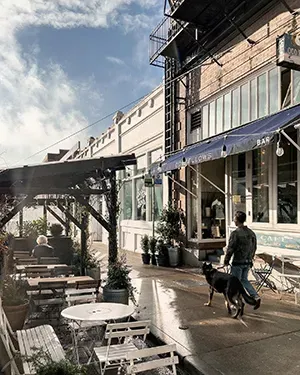Outdoor dining spaces took Seattle's main stage last year as restaurants grappled with the paradox of returning to normal amid the COVID-19 pandemic. Sidewalk cafés and parking spots were transformed into dining spaces – dubbed "streateries," equal parts "street" and "eatery" – quickly rose in popularity in 2020 and brought hesitant Seattleites out of the house once again.
As we endure our second winter of pandemia, with the ultracontagious Omicron variant infiltrating virtually every nook of the city, these strategic spaces will remain crucial for the safety of customers and the vitality of local businesses alike.
Parking spaces reimagined
Unbeknownst to many, the Seattle Department of Transportation (SDOT) first rolled out the concept of streateries several years prior to the pandemic.
In 2013, SDOT first encouraged local businesses and organizations to host "parklets," a sort of miniature public park in right-of-way parking spaces. Streateries were then piloted in 2015 as a restaurant-specific opportunity to take advantage of limited outdoor space.
SDOT's announcement of the program cited the success of Portland's "Street Seats" Program, which began in 2012, and Montreal's long-standing "Terrasses" program. Both examples were well received and beneficial to local businesses.
SDOT monitored the implementation of the Parklet and Streateries Programs in Seattle for over a year. The data concluded that these spaces activated our city streets, creating more vibrant neighborhoods, and overall promoted economic vitality for local restaurants and businesses. One hundred percent of participating business owners reported that a parklet or streatery space improved their business.
Pre-pandemic, the permitting process for streateries would cost a restaurant anywhere between $2,000 and $4,700 per year, depending on the size and zone of the parking spot. However, the City of Seattle began providing free temporary permits to eligible businesses upon the state's reopening.
Introduced by Councilmembers Dan Strauss (District 6) and Lorena Gonzales (at-large) in June 2020, the "Cafe Streets" legislation has allowed Seattle eateries to stay open safely and has been extended twice over the last year and a half. Councilmembers recently announced that they are seeking a path to permanency for the program.
This move would "provide businesses the certainty they need to invest in their outdoor spaces and the agility to remain open during changing public health guidelines," according to Strauss. "This is how we create a more vibrant city," he said.
The Cafe Streets legislation is expected to be heard in Strauss's Land Use and Neighborhoods Committee on Wednesday, May 12, 2021.
Pandemic-era eating
Now that the pandemic has impacted Seattle for nearly two years, outdoor dining has become a strategic crisis-response move by bars and restaurants.
It is now known that people are less likely to contract COVID-19 outdoors than they are indoors. Outdoor seating also accommodates physical distancing more easily than indoor spaces do.
Adapting to these new demands for safety has been a beneficial move for patrons and business owners alike. With fewer infections likely spreading from customer to staff, businesses with streateries have been able to stay open much more consistently while others have faced staffing shortages.
In late 2021, between the Delta and Omicron editions of the pandemic, people began to feel safer. Restaurants and small businesses saw a pre-holiday boom in profits. People were clubbing again. The seven-day average of new COVID-19 cases on November 28 was 206 per day for the whole of King County.
Then came Omicron. According to the King County COVID-19 dashboard, this week's seven-day average is upwards of 4,600 confirmed new cases per day. Some bars and restaurants are closing due for safety reasons.
There is one thing sticking around, though: streateries. On Sunday, Ballard Avenue's line of heated pergolas saw wait times of up to 45 minutes by lunch. Each streatery, featuring cozy decor, overhead heating, and room to breathe between tables, was bustling with food service and enjoyment.
Moving forward, restaurants with outdoor seating options offer the safest version of the dining experience for workers and customers. (And psst! Delivery is also an option.)
If you plan to go out for a bite, it's time to hit some winterized streateries. Find a live list of heated streateries from the Seattle Met at https://www.seattlemet.com/eat-and-drink/seattle-restaurants-and-bars-with-covered-heated-and-tented-patios.


